Click on images to enlarge
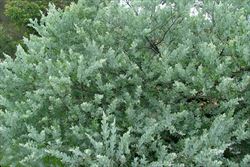
habit in autumn (Photo: Sheldon Navie)
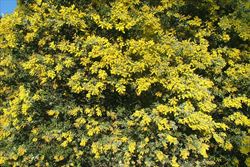
habit in flower during winter (Photo: Sheldon Navie)
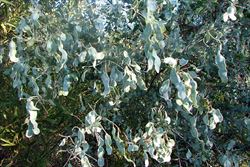
habit with immature fruit during spring (Photo: Sheldon Navie)
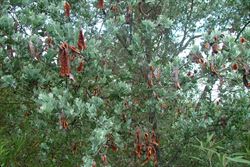
habit with mature fruit during summer (Photo: Sheldon Navie)
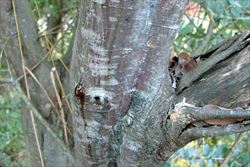
main trunk with relatively smooth greyish-brown bark (Photo: Sheldon Navie)
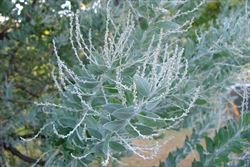
young flower clusters (Photo: Sheldon Navie)
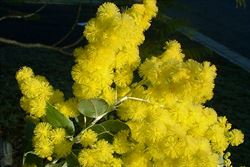
close-up of the small globular flower clusters (Photo: Sheldon Navie)
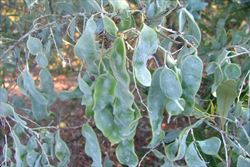
flattened immature fruit with somewhat twisted or undulating margins (Photo: Sheldon Navie)
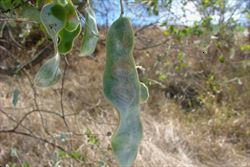
close-up of immature fruit showing the whitish hairs and powdery coating (Photo: Sheldon Navie)
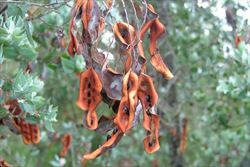
mature fruit are reddish-brown inside and duller brown outside (Photo: Sheldon Navie)

close-up of the black seeds, each with a small fleshy aril (Photo: Sheldon Navie)
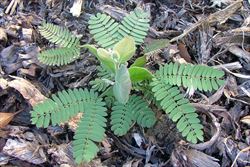
a young seedling with remnant twice-compound leaves on the tips of its developing phyllodes (Photo: Sheldon Navie)
Scientific Name
Acacia podalyriifolia A. Cunn. ex G. Don
Synonyms
Acacia fraseri Hook.
Acacia podalyriaefolia A. Cunn. ex G. Don
Acacia podalyriaefolia A.Cunn. ex G. Don var. viridis Guilf.
Acacia podalyriifolia A. Cunn. ex G. Don var. podalyriifolia
Acacia podalyriifolia A. Cunn. ex G. Don var. typica Domin
Acacia podalyriifolia A. Cunn. ex G. Don var. viridis Guilf.
Racosperma podalyriifolium (A. Cunn. ex G. Don) Pedley
Family
Fabaceae: sub-family Mimosoideae (New South Wales)
Leguminosae (South Australia)
Mimosaceae (Queensland, the ACT, Victoria, Tasmania, Western Australia and the Northern Territory)
Common Names
Mount Morgan wattle, Mt. Morgan wattle, pearl acacia, pearl wattle, Queensland silver wattle, Queensland wattle, silver wattle
Origin
Native to some parts of central and southern Queensland and north-eastern New South Wales. It is common in Queensland, particularly in the south-east of the state, and ranges from Mount Morgan inland to the Carnarvon Range in central Queensland and south-east to Stanthorpe in the extreme south of the state. In New South Wales it is known only from the Legume district on the northern tablelands, near the Queensland-New South Wales border.
Cultivation
This species is widely cultivated throughout Australia because of its highly decorative masses of bright golden-yellow flowers and its silvery-grey foliage. It is in fact one of the most popular wattles in cultivation and can therefore also be seen growing in parks and gardens in many parts of the country.
There is a relatively rare variant with greenish coloured foliage (which has sometimes erroneously been called Acacia podalyriifolia var. viridis) in cultivation. Garden hybrids involving this species have also been developed, particularly in southern Europe. These include: Acacia x deneufvillei L. Winter ex A. Berger (Acacia podalyriifolia x Acacia pycnantha), Acacia x hanburyana L. Winter ex A. Berger (Acacia podalyriifolia x Acacia dealbata), and Acacia x siebertiana L. Winter ex A. Berger (Acacia podalyriifolia x Acacia pycnantha).
Naturalised Distribution
Naturalised beyond its native range in many parts of southern and central New South Wales. It is most common in the Sydney and Blue Mountains regions, but is also present in the coastal and inland regions of southern New South Wales. Also well established in the coastal districts of south-western Western Australia and near Adelaide in south-eastern South Australia. It has recently become naturalised in a few parts of Victoria (i.e. in northern areas and near Melbourne) and is possibly also naturalised on the Eyre Peninsula in South Australia. Because this species is so commonly cultivated in Brisbane, and was also one of the first native plants brought into cultivation in Queensland, many of the populations present in the Brisbane area may actually be derived from garden escapes. It is also naturalised in North Queensland, around Herberton.
Queensland silver wattle (Acacia podalyriifolia) has been cultivated in many other parts of the world, particularly in warmer regions. After escaping from cultivation it has also become naturalised in southern and eastern Africa (i.e. South Africa, Zimbabwe, Uganda, Tanzania, Malawi, Kenya and Ethiopia), in some parts of the Indian sub-continent and south-east Asia (i.e. India, Sri Lanka, Indonesia and Malaysia), on some Indian Ocean islands (i.e. Mauritius and La Reunion), in New Zealand, in South America (i.e. Brazil and Argentina), and in North America (i.e. in California in south-western USA).
Habitat
In the southern parts of its natural range this species occurs in a wide variety forests and woodlands, but is mainly found growing in rocky soils on hills and ridges. In the northern parts of its range it is more or less restricted to sandstone hills in open sclerophyll forests.
Where Queensland silver wattle (Acacia podalyriifolia) has escaped from gardens and become naturalised, it is most frequently found along roadsides and spreading into nearby bushland. However, it has become naturalised in a wide range of habitats in New South Wales. In South Africa this species also invades watercourses (i.e. riparian habitats) and open spaces in urban areas.
Habit
An upright (i.e. erect) and spreading shrub or small tree usually growing 2-6 m tall, but occasionally reaching up to 10 m in height. It is relatively short-lived, usually only having a lifespan of 10-15 years.
Distinguishing Features
- a shrub or small tree with alternately arranged simple 'leaves' that are silvery-grey or bluish-green in colour.
- its young branches and immature fruit have a whitish powdery or waxy coating that gives them a frosty appearance.
- its 'leaves' are relatively short and broad (about twice as long as they are wide) and have a single prominent vein near their centre.
- its golden-yellow flowers are borne in small globular clusters (5-8 mm across) that are arranged into larger elongated compound clusters.
- its elongated and flattened pods (5-12 cm long) are velvety hairy when young with wavy margins.
Seedling
Stems and Leaves
The bark on the main trunk is grey or greyish-brown in colour and either relatively smooth or finely fissured. Younger branches are round or almost round in cross-section (i.e. terete or sub-terete) and velvety in nature, with a dense covering of soft spreading hairs (i.e. pubescent). They are also conspicuously whitish or bluish-green (i.e. glaucous) in colour due to the presence of a powdery substance (i.e. they are pruinose).
The 'leaves' of this plant are actually flattened and widened leaf stalks (i.e. petioles), and not leaves in the true sense of the word. These modified leaf stalks are called phyllodes, but serve the same function as a regular leaf. On very young plants, partially formed phyllodes can be seen which bear twice-compound (i.e. bipinnate) leaves at their tips, each with a single pair of branchlets (i.e. pinnae) bearing numerous leaflets (i.e. pinnules). As the seedling grows, each new 'leaf' has phyllodes that are more fully formed and the leaves at their tips eventually vanish altogether.
The phyllodes are alternately arranged along the stems, relatively thin, and broad (i.e. elliptic, oblong or ovate), generally being only 1.4-2.5 times longer than they are wide. These phyllodes (20-50 mm long and 10-27 mm wide) are relatively straight, sometimes with slightly wavy margins, and usually silvery-grey to bluish-green (i.e. glaucous) in colour (particularly when they are young). They usually only have a sparse covering of velvety hairs on both surfaces, but these hairs are much more apparent along the margins. However, sometimes the phyllode surfaces are almost hairless (i.e. sub-glabrous), particularly as they become older. Older phyllodes are occasionally dull green in colour and are sometimes covered in a black sooty mould. Each phyllode has a single prominent vein (i.e. midrib) that is usually slightly closer to the upper margin. The tips of the phyllodes are rounded (i.e. obtuse) to pointed (i.e. acute) in nature, but usually also have a tiny pointy extension (i.e. they are mucronate). At the base of each phyllode there is a very short structure (1-2 mm long) that looks like a leaf stalk (i.e. pulvinus). On the upper edge of the phyllode, between 5 and 25 mm above its base, there is a tiny raised structure (i.e. gland).
Flowers and Fruit
The small bright yellow or golden-yellow flowers are fluffy in appearance due to the presence of numerous stamens. These flowers have five relatively inconspicuous petals and sepals and are densely arranged into small globular clusters (5-8 mm across) containing 15-30 flowers. The small globular flower clusters are borne on short slender stalks (i.e. peduncles) 3-10 mm long and are alternately arranged on a short branch (2-11 cm long) emanating from the forks (i.e. axils) of the upper leaves. These much larger elongated compound clusters usually contain 8-22 of the small globular flower clusters (i.e. they form inflorescences resembling racemes) and are usually significantly longer than the leaves. The flowering branches and flower stalks (i.e. peduncles) are silvery-grey in colour and velvety in nature, like the other branchlets. Flowering generally occurs during winter in its natural range (i.e. from May to July), but may occur later in the year in cooler climates (i.e. in Augest and September).
The fruit is an oblong or somewhat elongated pod (50-120 mm long and 10-22 mm wide) that is borne on a short stalk and has prominent margins. These pods are flattened and relatively thin, straight but often somewhat twisted or with undulating margins. They are velvety hairy (i.e. pubescent), bluish-green or silvery-grey in colour, and covered in a whitish bloom (i.e. pruinose) when young. The pods become hairless (i.e. glabrous) and turn brown or reddish-brown in colour as they mature. When fully mature they split open on one side to release several seeds. Fruit are normally present from mid-spring through to early summer (i.e. from October to December). The seeds are black in colour, oblong in shape (6-7.5 mm long and 3-4 mm wide), dull in appearance, and have a fleshy structure (i.e. aril) attached to them.
Reproduction and Dispersal
Reproduction of this species is by long-lived seed that have a prolonged dormancy. Germination of these seeds peaks after fires and other forms of disturbance.
The seeds are most commonly dispersed by ants and birds, that are attracted by the fleshy arils attached to the seeds. However, they are probably also spread by wind, water, and in dumped garden waste.
Environmental Impact
Queensland silver wattle (Acacia podalyriifolia) is regarded as an environmental weed in New South Wales, Victoria, South Australia and Western Australia.
It is currently most widespread and troublesome where it has become naturalised beyond its native range in New South Wales. This is largely due to the fact that it has been widely cultivated in New South Wales for a very long period of time. It appears on numerous environmental weed lists for the Sydney and Blue Mountains regions and is becoming a serious weed of natural plant communities in these areas. In these regions it mainly occurs along road and rail corridors where ongoing disturbance has given planted specimens the opportunity to spread. It is most problematic in the western areas of Sydney, particularly along and near the Great Western Highway and the western rail line through the Blue Mountains. Queensland silver wattle (Acacia podalyriifolia) is also one of the two most frequently naturalised species of wattle on the south coast of New South Wales. It is also considered a potential problem in the coastal districts of northern New South Wales, where it has been included on the North Coast Environmental Weed Survey List.
Queensland silver wattle (Acacia podalyriifolia) is also a garden escape in the Perth area and around other settlements in south-western Western Australia. It grows well in the laterite soils of these areas and is largely found along roadsides and spreading into adjacent bushland. In Victoria it has become locally invasive in a few areas, but is not yet very widespread. In these areas it has been observed to spread from initial deliberate plantings into nearby dry sclerophyll forests and woodlands. In South Australia it is also not yet very widespread, and has only been recorded as naturalised in and around Adelaide.
In South Africa, where it is relatively widespread, Queensland silver wattle (Acacia podalyriifolia ) competes with and has the potential to replace indigenous species and is therefore regarded as a 'potential transformer' of natural vegetation.
Legislation
This species is not declared or considered noxious by any state or territory government in Australia.
Management
For information on the management of this species see the following resources:
- the Woody Weeds Information Pamphlet on the Environmental Weeds Action Network (EWAN) website at http://members.iinet.net.au/~ewan/.
Similar Species
Queensland silver wattle (Acacia podalyriifolia) may be confused with several other species of native wattles (Acacia spp.), particularly those that have silvery-grey coloured leaves. Similar species include knife-leaved wattle (Acacia cultriformis), Bendethera wattle (Acacia covenyi), Acacia jucunda and Cootamundra wattle (Acacia baileyana). These species can be distinguished by the following differences:
- Queensland silver wattle (Acacia podalyriifolia) has silvery-grey simple 'leaves' (i.e. phyllodes) that are usually somewhat hairy and relatively short and broad (1.4-2.5 times longer than wide). Its flowers are borne in small globular clusters, with several to many of these clusters being arranged into larger elongated compound clusters (i.e. racemes). The pods are relatively large (50-120 mm long and 10-22 mm wide) and flattened.
- knife-leaved wattle (Acacia cultriformis) has silvery-grey simple 'leaves' (i.e. phyllodes) that are hairless and knife-shaped, triangular or almost rounded in shape. Its flowers are borne in small globular clusters, with several to many of these clusters being arranged into larger elongated compound clusters (i.e. racemes). The pods are moderately large (up to 90 mm long and 5-8 mm wide) and flattened.
- Bendethera wattle (Acacia covenyi) has silvery-grey simple 'leaves' (i.e. phyllodes) that are hairless and relatively elongated in shape. Its flowers are borne in small globular clusters, with several to many of these clusters being that are arranged into larger elongated compound clusters (i.e. racemes). The pods are relatively large (up to 80 mm long and 9-13 mm wide) and flattened.
- Acacia jucunda has silvery-grey simple 'leaves' (i.e. phyllodes) that are usually slightly hairy and relatively long (2-5 times longer than wide). Its flowers are borne in small globular clusters, with several to many of these clusters being arranged into larger elongated compound clusters (i.e. racemes). The pods are relatively large (up to 90 mm long and 8-10 mm wide) and flattened.
- Cootamundra wattle (Acacia baileyana) has silvery-grey twice-compound (i.e. bipinnate) leaves that are usually hairless with a few (2-6) pairs of branchlets. Its flowers are borne in small globular clusters, with several to many of these clusters being arranged into larger elongated compound clusters (i.e. racemes or panicles). The pods are relatively large (30-120 mm long and 8-15 mm wide) and flattened.
Note: This page only covers those species that have been reported to be commonly confused with Queensland silver wattle (Acacia podalyriifolia). For a more in-depth key to all of the wattles (Acacia spp.) present in Australia, see the Wattle: Acacias of Australia CD-ROM or Flora of Australia, Volumes 11A and 11B.

